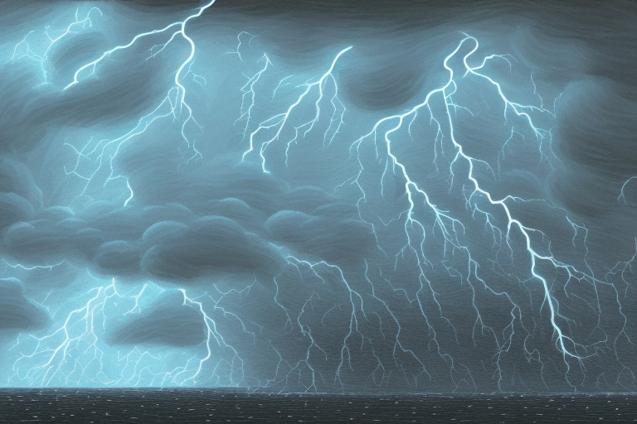
Sailing through a thunderstorm can be an awe-inspiring and humbling experience. Learn how to prepare for and navigate through these powerful natural phenomena.
The Awe of Sailing Through a Thunderstorm: A Powerful Experience
Sailing through a thunderstorm is an experience that is both awe-inspiring and humbling. It is a powerful reminder of the forces of nature and the vulnerability of our small vessels in the face of such elemental power. In this article, we will explore the unforgettable experience of sailing through a thunderstorm, sharing personal stories and insights from those who have lived through it. We will also provide practical advice for those who may find themselves in a similar situation, helping you to navigate the storm safely and with confidence.
The Beauty and Terror of a Thunderstorm at Sea
There is something undeniably beautiful about a thunderstorm at sea. The dark, brooding clouds, the flashes of lightning illuminating the night sky, and the rolling thunder echoing across the water all combine to create a breathtaking spectacle. However, this beauty is also tinged with a sense of terror, as the power of the storm becomes all too apparent.
For many sailors, the experience of sailing through a thunderstorm is one that will stay with them for a lifetime. The combination of fear, adrenaline, and awe can be intoxicating, and the memories of the storm will often be recounted with a mixture of pride and trepidation.
A Personal Account: Sailing Through a Storm in the Caribbean
One sailor, who we will call John, shared his experience of sailing through a thunderstorm while on a family sailing trip in the Caribbean. John and his family were sailing a 40-foot catamaran, and they had been enjoying a beautiful day of sailing when the weather suddenly took a turn for the worse.
As the storm approached, John and his family quickly reefed the sails and prepared the boat for the rough conditions ahead. The wind began to pick up, and the waves grew larger, causing the boat to pitch and roll violently. As the rain began to pour down, visibility was reduced to almost zero, and the family huddled together in the cockpit, trying to stay warm and dry.
The lightning was the most terrifying aspect of the storm for John and his family. The flashes were so bright and frequent that it was almost like daylight, and the thunder was deafening. John knew that the risk of a lightning strike was very real, and he did his best to keep the boat pointed into the wind and away from the worst of the storm.
After several hours of battling the storm, the weather finally began to clear, and the family was able to continue on their journey. While the experience was undoubtedly frightening, John also found it to be incredibly exhilarating and awe-inspiring. He felt a deep sense of gratitude for having survived the storm and for the opportunity to witness the raw power of nature firsthand.
Preparing for a Thunderstorm at Sea
While it is impossible to predict when and where a thunderstorm will strike, there are steps that sailors can take to prepare for the possibility of encountering a storm at sea. By being prepared and knowing how to react in the face of a thunderstorm, you can greatly increase your chances of navigating the storm safely and without incident.
Monitoring the Weather
One of the most important aspects of preparing for a thunderstorm is to closely monitor the weather. This means keeping an eye on the sky, as well as regularly checking weather forecasts and updates. If you notice dark, towering clouds on the horizon, or if the forecast calls for thunderstorms in your area, it is essential to take the necessary precautions and be prepared for the possibility of a storm.
Securing the Boat
As a storm approaches, it is crucial to secure your boat and make sure that everything is in order. This includes reefing the sails, securing any loose items on deck, and ensuring that all hatches and portholes are closed and watertight. It is also a good idea to don your lifejackets and harnesses, as the conditions can become rough and unpredictable during a storm.
Lightning Protection
One of the greatest dangers during a thunderstorm is the risk of a lightning strike. While it is impossible to completely eliminate this risk, there are steps that you can take to minimize the potential damage caused by a strike. This includes installing a lightning protection system on your boat, which can help to direct the energy from a lightning strike safely into the water, rather than through the boat’s electrical systems and hull.
Navigating the Storm
When sailing through a thunderstorm, it is important to keep a close eye on your surroundings and to maintain a steady course. This can help to minimize the risk of being caught off guard by a sudden gust of wind or a large wave. It is also a good idea to keep the boat pointed into the wind, as this can help to reduce the risk of a knockdown or capsize.
The Aftermath: Lessons Learned and Stories Shared
Once the storm has passed, it is important to take stock of the experience and to learn from it. This may involve assessing any damage to the boat, as well as discussing the events of the storm with your crew and fellow sailors. By sharing your experiences and learning from the stories of others, you can become better prepared for future storms and gain a deeper appreciation for the power and beauty of nature.
In conclusion, sailing through a thunderstorm is an unforgettable experience that can be both awe-inspiring and humbling. By being prepared, staying vigilant, and respecting the power of nature, you can navigate the storm safely and emerge with a newfound appreciation for the open sea and the adventures that await.